

101st Street. Fort Dix. Census-designated place in New Jersey, United States Fort Dix, the common name for the Army Support Activity located at Joint Base McGuire-Dix-Lakehurst, is a United States Army post.
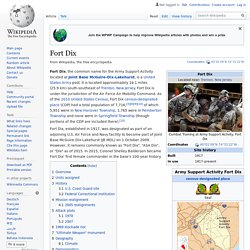
It is located approximately 16.1 miles (25.9 km) south-southeast of Trenton, New Jersey. Fort Dix. Fort Dix, the common name for the Dix unit of Joint Base McGuire-Dix-Lakehurst, is a former United States Army post (now Army Support Activity under jurisdiction of the United States Air Force's 87 ABW) located approximately 16.1 miles (25.9 km) south-southeast of Trenton, New Jersey.
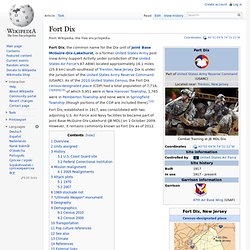
Dix is under the jurisdiction of the United States Army Reserve Command (USARC). As of the 2010 United States Census, the Fort Dix census-designated place (CDP) had a total population of 7,716,[3][8][9][10] of which 5,951 were in New Hanover Township, 1,765 were in Pemberton Township and none were in Springfield Township (though portions of the CDP are included there).[10] Fort Dix, established in 1917, was consolidated with two adjoining U.S. Air Force and Navy facilities to became part of Joint Base McGuire-Dix-Lakehurst (JB MDL) on 1 October 2009. However, it remains commonly known as Fort Dix as of 2012. Overview[edit] The host unit at Dix is the United States Air Force 87th Air Base Wing (87 ABW). U.S. Fort Benjamin Harrison.
Fort Benjamin Harrison was a U.S.
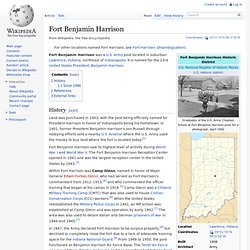
Army post located in suburban Lawrence, Indiana, northeast of Indianapolis. It is named for the 23rd United States President, Benjamin Harrison. History[edit] Land was purchased in 1903, with the post being officially named for President Harrison in honor of Indianapolis being his hometown. In 1901, former President Benjamin Harrison's son Russell through lobbying efforts sold a nearby U.S. Fort Benjamin Harrison saw its highest level of activity during World War I and World War II. In 1947, the Army declared Fort Harrison to be surplus property,[8] but declined to completely close the fort due to a lack of adequate training space for the Indiana National Guard.[9] From 1948 to 1950, the post functioned as Benjamin Harrison Air Force Base.
The U.S. Fort Benjamin Harrison. Former US Army post in Indianapolis, IN, US 1906-1991 United States historic place Fort Benjamin Harrison was a U.S.

Fort Bragg. History[edit] One of the signs at an entrance to the post.

World War I[edit] Camp Bragg was established in 1918, as an artillery training ground. The aim was for six artillery brigades to be stationed there and $6,000,000 was spent on the land and cantonments.[2] There was an airfield on the camp used by aircraft and balloons for artillery spotters which was named Pope Field on April 1, 1919 in honor of First Lieutenant Harley H. Pope[2] an airman who was killed while flying nearby. The original plan for six brigades was abandoned after World War I ended[2] and once demobilisation had started. Fort Campbell. History[edit] The site for Fort Campbell was selected on July 16, 1941, and the Title I Survey was completed November 15, 1941, coincidentally the same time the Japanese Imperial Fleet was leaving Japanese home waters for the attack on Pearl Harbor.
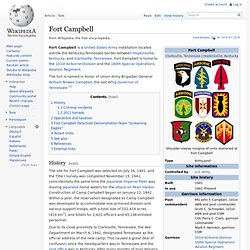
Construction of Camp Campbell began on January 12, 1942. Within a year, the reservation designated as Camp Campbell was developed to accommodate one armored division and various support troops, with a total size of 102,414 acres (414 km2), and billets for 2,422 officers and 45,198 enlisted personnel. In the spring of 1949, the 11th Airborne Division arrived at Campbell following occupation duty in Japan. The 11th was in residence there until early 1956. By April 1950, the post had evolved from a wartime training camp to a permanent installation and was renamed Fort Campbell. Fort Campbell. United States Army installation History[edit] Command and control facility for 101st Airborne Division at Fort Campbell The site for Fort Campbell was selected on July 16, 1941, and the Title I Survey was completed November 15, 1941, coincidentally the same time the Japanese Imperial Fleet was leaving Japanese home waters for the attack on Pearl Harbor.
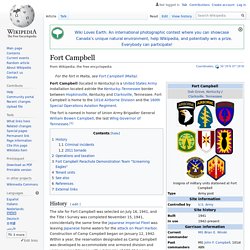
Construction of Camp Campbell began on January 12, 1942. Within a year, the reservation designated as Camp Campbell was developed to accommodate one armored division and various support troops, with a total size of 102,414 acres (414 km2), and billets for 2,422 officers and 45,198 enlisted personnel. 101st Airborne Division. Active United States Army formation The 101st Airborne Division has a history that is over a century long.
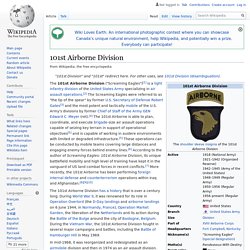
During World War II, it was renowned for its role in Operation Overlord (the D-Day landings and airborne landings on 6 June 1944, in Normandy, France), Operation Market Garden, the liberation of the Netherlands and its action during the Battle of the Bulge around the city of Bastogne, Belgium. During the Vietnam War, the 101st Airborne Division fought in several major campaigns and battles, including the Battle of Hamburger Hill in May 1969. In mid-1968, it was reorganized and redesignated as an airmobile division and then in 1974 as an air assault division. The titles reflect the division's shift from airplanes to helicopters as the primary method of delivering troops into combat. History[edit] World War I and interwar period[edit] World War II to Present Day[edit] On 30 July 1942, the Army Ground Forces ordered the activation of two airborne divisions not later than 15 August 1942.